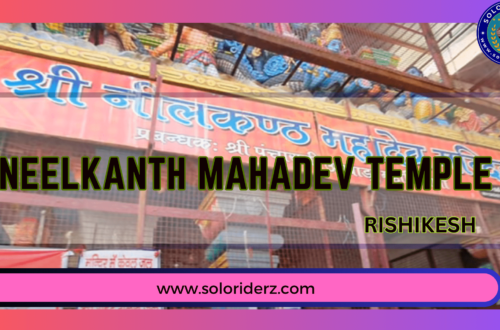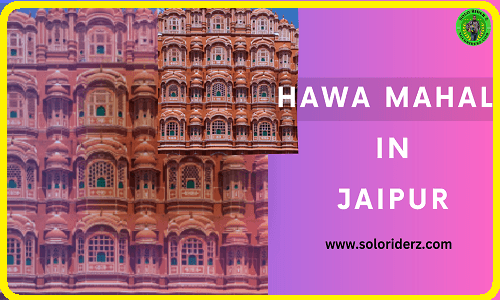
Hawa Mahal in Jaipur
- Hawa Mahal: The Palace of Winds
- A Glimpse into History and importance of Hawa Mahal in Jaipur
- Architectural Marvels
- The View from Within
- Planning Your Visit to Hawa Mahal in Jaipur
- Places to Visit Near Hawa Mahal
- Cheap and Best Hotels to stay near Hawa Mahal
- useful Links
- Conclusion
- FAQs about Traveling to Hawa Mahal
Hawa Mahal: The Palace of Winds
In the heart of Jaipur, the Pink City of Rajasthan, stands a mesmerizing architectural wonder known as Hawa Mahal, or the Palace of Winds. The importance of hawa mahal is its unique and iconic structure, is a testament to the rich history, intricate craftsmanship, and artistic excellence of the Rajput rulers. Let’s delve into the history and captivating features of Hawa Mahal.
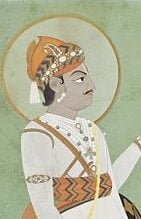
A Glimpse into History and importance of Hawa Mahal in Jaipur
Built by Maharaja Sawai Pratap Singh: Hawa Mahal was constructed in 1799 by Maharaja Sawai Pratap Singh, who was inspired by the unique architecture of the Khetri Mahal. The palace was designed by Lal Chand Ustad, an architect of the Rajputana Kingdom.
Purpose: The unique design of Hawa Mahal was not just for aesthetics; it served a practical purpose. It was constructed to allow royal women, who observed strict purdah (veil) norms, to watch street processions and daily life without being seen by the public.
Name Origin: The name “Hawa Mahal” translates to “Palace of Winds” in English, and it aptly reflects the structure’s unique feature of allowing cool, breezy air to flow through its numerous windows and latticework.
Unique Design: Hawa Mahal is renowned for its distinctive honeycomb-like pink sandstone structure, which resembles the shape of a crown. It has 953 small windows or jharokhas, which are intricately designed with latticework. These windows were built to allow royal ladies to observe the outside world while maintaining their privacy.
Architectural Marvels
Hawa Mahal is renowned for its distinctive architectural features:
Facade: The most striking feature of Hawa Mahal is its intricate and ornate facade. It boasts 953 small windows, known as jharokhas, which are adorned with intricate latticework, creating an effect resembling a honeycomb.
Five Stories: Although Hawa Mahal appears to be a grand palace from the front, it is only one room deep. The structure extends five stories to the rear, offering a concealed and well-ventilated space for the royal women.
The top floors offer panoramic views of the city, including the City Palace, Jantar Mantar, and the Siredeori Bazaar.
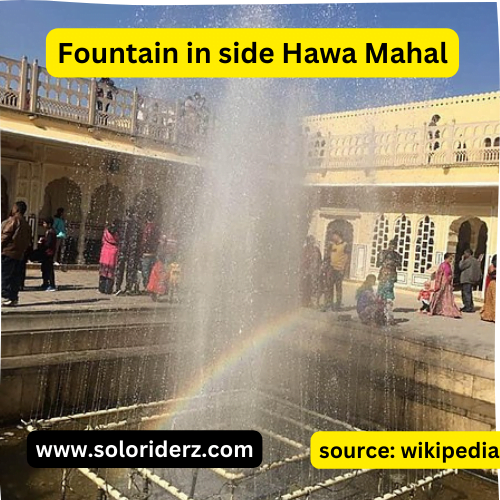
Cooling System: The architecture of Hawa Mahal was ingeniously designed to capture and channel cool air through the jharokhas, creating a natural air conditioning effect, which was much appreciated in the hot desert climate of Rajasthan.
Symbolic Representation: The architecture of Hawa Mahal is said to symbolize Lord Krishna’s crown or the mukut, which is a popular deity in Hinduism. The pink sandstone represents the tradition of welcoming guests with a warm and hospitable heart.
Historical Significance: Hawa Mahal served as a place where the royal women of the palace could observe the city’s festivities and daily life without being seen by the public. It was an important aspect of their social and cultural life.
Night Illumination: Hawa Mahal looks even more enchanting at night when it is beautifully illuminated, making it a popular tourist attraction after sunset.
Part of UNESCO World Heritage Site: Hawa Mahal is a part of the historic city of Jaipur, which is designated as a UNESCO World Heritage Site. It is one of the key attractions that showcases the rich heritage and culture of Rajasthan.
Tourist Attraction: Today, Hawa Mahal is one of the most iconic tourist attractions in Jaipur and is often featured in various travel guides and postcards. Visitors can explore the museum located inside the palace, which displays artifacts related to the royal history of Rajasthan.
Location: Hawa Mahal is located in the heart of the bustling Old City of Jaipur, making it easily accessible to tourists and a great starting point for exploring the city’s other historical landmarks.
Hawa Mahal is not only an architectural marvel but also a symbol of Jaipur’s rich history and culture, making it a must-visit destination for anyone traveling to the Pink City. Foth that you must have a well planned itinerary, check this 2 day Jaipur Itinerary to plan your trip.
The View from Within
While Hawa Mahal’s exterior is captivating, its interior also holds historical significance. The palace features a museum that showcases various artifacts and relics from Rajasthan’s royal history. Visitors can explore the different chambers and get a sense of the luxurious lifestyle of the Rajput royals.
Planning Your Visit to Hawa Mahal in Jaipur
Timing: Hawa Mahal is open from 9:00 AM to 5:00 PM and is typically less crowded during the early morning hours.
Accessibility: The palace is centrally located in Jaipur and is easily accessible by road. It’s a short drive from other popular attractions in the city.
Hawa Mahal ticket price: There is a nominal entry fee for both Indian and foreign tourists. Before visiting please check the entry fee price. When I last visited in the year 2020, the entry fee or hawa mahal ticket price for
- Indian was Rs.50/-. per person.
- And for foreigners it was Rs.200/- per person.
As on today, the entry fee might be changed. Please check the latest fee rates before visiting.
Photography: Don’t forget to bring your camera! Hawa Mahal offers fantastic opportunities for photography, both from the outside, where you can capture its intricate facade, and from the inside, where you can explore the museum and enjoy the view.
Hawa Mahal is not just an architectural marvel; it’s a symbol of Rajasthan’s rich heritage and the ingenuity of its builders. A visit to this splendid palace allows you to step back in time and appreciate the opulence and artistry of the Rajput era. Whether you’re a history enthusiast, an architecture lover, or simply seeking a unique cultural experience, Hawa Mahal is a must-visit attraction in Jaipur that will leave you awe-inspired and enchanted.
Visiting Hawa Mahal in Jaipur offers a unique and enriching experience. While the palace itself is a remarkable architectural wonder, there are several things you can do when you visit Hawa Mahal and its surrounding area:
Explore the Facade: The intricate facade of Hawa Mahal is a sight to behold. Spend some time admiring the 953 small windows (jharokhas) with their exquisite latticework. It’s a photographer’s paradise, so don’t forget your camera.
Learn about History: Visit the museum inside Hawa Mahal to gain insights into the history and culture of Rajasthan. The museum houses various artifacts and relics from the region’s royal past.
Enjoy the View: Ascend to the upper floors of Hawa Mahal, where you can enjoy panoramic views of Jaipur’s bustling streets and the cityscape. It’s particularly enchanting during sunrise and sunset.
Shop for Souvenirs: Around Hawa Mahal, you’ll find numerous shops and street vendors selling Rajasthani handicrafts, jewelry, textiles, and souvenirs. You may shop for memento and gifts for you as a souvenir.
Places to Visit Near Hawa Mahal
Explore the Surrounding Area: Hawa Mahal in Jaipur is located in the heart of the Pink City. As the day starts. the streets of Jaipur are so so.. vibrant around Hawa Mahal, that you forget yourself and get immersed with the flow. As you explore the market and talk to locals they will tell you the interesting stories about Hawa Mahal while exploring the nearby markets. Learn more about their traditions, folklore and the warm hospitality that defines the spirit of Jaipur. Do enjoy the delicious local cuisine, and immerse yourself in the city’s culture.
Visit Jantar Mantar: Located nearby, the Jantar Mantar is an astronomical observatory and UNESCO World Heritage Site. It’s a fascinating place to explore the historic astronomical instruments. From the terrace of Hawal Mahal in Jaipur, you may see the Jantar mantar.
Discover City Palace: The City Palace, another iconic attraction, is also within close proximity to Hawa Mahal. You can explore the palace complex and its museums to learn more about Jaipur’s royal heritage.
Attend Cultural Events: Check if there are any cultural events or festivals happening in the vicinity of Hawa Mahal during your visit. Rajasthan is known for its colorful celebrations, and you might get the chance to witness traditional music, dance, and festivities.
Enjoy Local Food: Opposite of Hawa Mahal in Jaipur restaurant. From this restaurant roof top you may get a beautiful picturistic view of Hawa mahal. Mostly the tourist visit this restaurant especially for taking the picture with the Hawa mahal. Jaipur is famous for its culinary delights. Don’t miss the opportunity to savor Rajasthani dishes like dal baati churma, gatte ki sabzi, and sweets like ghewar and rasgulla at local eateries around Hawa Mahal.
Photography: Whether you’re an amateur or professional photographer, Hawa Mahal provides endless opportunities for capturing unique and stunning shots. Experiment with different angles and lighting to create memorable photographs.
Ajmer to Hawa Mahal: is about 136 km approximately through NH48. The total time to cover the distance is approx. 3 hours.
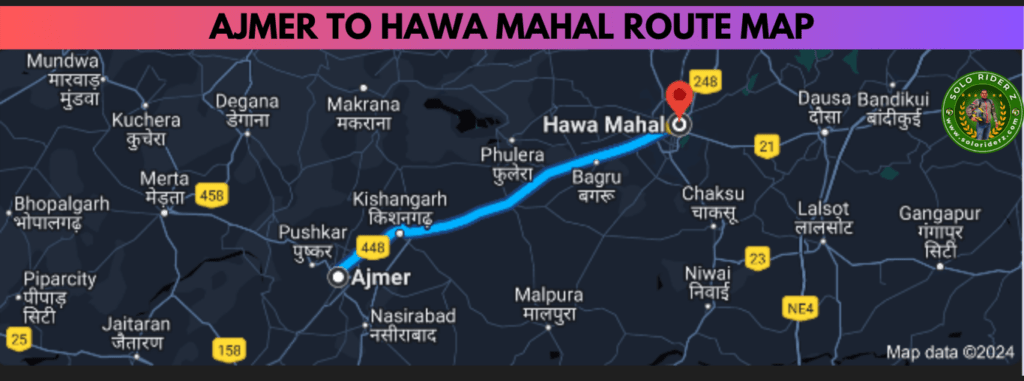
Visit Wikipedia to know more information in details about Hawa Mahal in Jaipur.
Cheap and Best Hotels to stay near Hawa Mahal
When exploring the magnificent Hawa Mahal in Jaipur, there are several budget-friendly yet excellent accommodation options nearby. Here are some cheap and best places to stay:
- Zostel Jaipur
- Location: 91, Pandit Shivji Marg, Badi Choupad
- About: Zostel Jaipur, a backpacker’s delight, is situated just a short distance from Hawa Mahal. With affordable dormitory options and a vibrant atmosphere, it’s an ideal choice for budget-conscious travelers.
- Hotel Pearl Palace
- Location: 51, Hathroi Fort, Ajmer Road
- About: Combining affordability with comfort, Hotel Pearl Palace is a charming option. It’s known for its friendly staff, clean rooms, and a rooftop restaurant offering a view of the city.
- Nahargarh Haveli
- Location: B – 4, Ajmer Road, Behind Corporate Park, Gopal Bari
- About: Nahargarh Haveli, with its traditional Rajasthani architecture, provides a cultural experience at budget-friendly rates. It’s close to both Hawa Mahal and the City Palace.
- Umaid Bhawan Heritage House Hotel
- Location: D1-2A,Behind Collectorate, (Via) Bank Road, Bani Park
- About: Offering a blend of heritage and affordability, Umaid Bhawan is a popular choice. The hotel’s decor reflects the grandeur of Rajasthan, and its proximity to major attractions is an added advantage.
- Vinayak Guesthouse
- Location: Kanwar Nagar, Opposite Brahmpuri Police Station
- About: Vinayak Guesthouse is a budget accommodation option with a homely atmosphere. The personalized service and clean rooms make it a reliable choice for travelers exploring Hawa Mahal.
- Hotel Kalyan
- Location: Behind Amber Tower, Sansar Chandra Road
- About: Hotel Kalyan is strategically located, making it convenient for visitors exploring Hawa Mahal and other attractions. The budget-friendly rooms and attentive staff enhance the overall experience.
- Krishna Palace
- Location: E-26 Durga Marg, Bani Park
- About: Krishna Palace offers a comfortable stay with modern amenities at affordable rates. The hotel’s central location ensures easy access to Hawa Mahal and other key landmarks.
- Hotel Haveli of Jaipur
- Location: 48, Gopal Bari, Lane 3, Behind Corporate Park
- About: With its traditional haveli architecture, this hotel provides a taste of Rajasthan’s rich heritage. It’s reasonably priced and well-connected to Hawa Mahal and the Old City.
- Sunder Palace Guest House
- Location: 46, Sanjay Marg, Hathroi Fort, Ajmer Road
- About: Sunder Palace Guest House offers a budget-friendly stay with a homely ambiance. The rooftop restaurant provides panoramic views of the city, making it a delightful choice for travelers.
- Hotel Ratnawali
- Location: 18, Vanasthali Marg, Opp. Lane of Pink Square Mall
- About: The Hotel Ratnawali is situated near Pink Square Mall. Hotel Ratnawali is known for its affordable rooms and proximity to Hawa Mahal. The welcoming staff ensures a pleasant stay for budget-conscious travelers.
These accommodations provide cheap and budget friendly options for stay without having extra burden on your wallet. Before booking, please check the google reviews about hotels and also the check the availability before making a reservation.
useful Links
Conclusion
Visiting Hawa Mahal is not just about seeing a beautiful building; it’s a chance to immerse yourself in Rajasthan’s rich history, culture, and architecture. Whether you’re interested in history, photography, or simply enjoying the ambiance of this iconic structure, Hawa Mahal offers a multitude of experiences for every traveler.
FAQs about Traveling to Hawa Mahal
- Q: Are there guided tours available at Hawa Mahal? A: Yes, guided tours are available, offering in-depth insights into the history and architecture of this magnificent palace.
- Q: What is the best time of day to photograph Hawa Mahal? A: The golden hours of sunrise and sunset provide the best lighting for capturing the beauty of Hawa Mahal.
- Q: Is photography allowed inside the palace? A: Photography is permitted in certain areas, but it’s advisable to check with the authorities and respect any restrictions.
- Q: Are there any cultural events held at Hawa Mahal? A: Occasionally, cultural events and performances take place in the vicinity, adding to the overall experience.
- Q: How much time should I allocate for a visit to Hawa Mahal? A: Plan for at least 2-3 hours to explore the palace thoroughly and absorb its historical and cultural significance.
- Q: Is there a specific significance to the pink color of Hawa Mahal? A: Yes, the pink hue symbolizes hospitality in Rajasthani culture. The entire city of Jaipur, including Hawa Mahal, was painted pink in 1876 to welcome the Prince of Wales.
- Q: Are there any legends associated with the construction of Hawa Mahal? A: According to local folklore, Hawa Mahal was built to allow the royal women to observe the street festivals and daily life without being seen, ensuring their privacy.
- Q: Can visitors climb to the top of Hawa Mahal for panoramic views? A: Unfortunately, the top floors are not accessible to the public. However, the breathtaking views can be enjoyed from the lower levels, providing a unique perspective of Jaipur.
- Q: How is Hawa Mahal illuminated at night? A: The facade of Hawa Mahal is beautifully lit up in the evening, creating a magical ambiance. The intricate lattice work and architectural details are accentuated by the lighting, offering a captivating sight.
- Q: Are there any annual events or festivals celebrated at Hawa Mahal? A: While there are no specific festivals held within the palace, it often becomes a focal point for celebrations during major cultural events in Jaipur, such as the Jaipur Literature Festival.
- Q: What inspired the unique honeycomb design of Hawa Mahal’s facade? A: The honeycomb design is not only aesthetically pleasing but also serves a purpose. It allows cool air to circulate through the palace, making it an early form of natural air conditioning in the arid climate of Rajasthan.
- Q: Can visitors explore the interiors of the Hawa Mahal? A: While the exterior is the main attraction, visitors can explore some of the inner chambers and corridors, each revealing a piece of the palace’s intriguing history and architecture.
- Q: How has Hawa Mahal withstood the test of time and weathering? A: The enduring quality of the pink sandstone used in construction contributes to the palace’s resilience. Restoration efforts also play a crucial role in preserving this architectural gem.
- Q: Are there any nearby attractions that complement a visit to Hawa Mahal? A: Yes, the City Palace and Jantar Mantar are in close proximity, offering a comprehensive experience of Jaipur’s rich heritage. Consider planning a day to explore these landmarks together.
- Q: Can you recommend the best spots for photography enthusiasts around Hawa Mahal? A: The area surrounding Hawa Mahal provides numerous picturesque spots. The view from the Sireh Deori Bazaar and the opposite rooftop cafes offer fantastic angles for capturing the palace.
- Q: Is there an optimal time of year to visit Hawa Mahal for pleasant weather? A: The months of October to March are ideal, with cooler temperatures making the visit more comfortable. However, be prepared for larger crowds during the peak tourist season.
- Q: How has Hawa Mahal served different purposes over the years? A: Initially built as an extension of the royal zenana (women’s quarters), Hawa Mahal has also been used for cultural events, making it a versatile architectural marvel.
- Q: What are the key elements of Rajput architecture showcased in Hawa Mahal? A: Hawa Mahal embodies key Rajput architectural elements, including chhatris (elevated dome-shaped pavilions), jharokhas, and intricate detailing, reflecting the grandeur of the era.
- Q: Are there any restrictions on entry for international visitors to Hawa Mahal? A: No, there are no specific restrictions. International visitors are welcome to explore and appreciate the beauty of Hawa Mahal like any other visitor.
- Q: Can visitors purchase souvenirs related to Hawa Mahal in the surrounding area? A: Absolutely! The nearby markets offer a variety of souvenirs, including miniature replicas of Hawa Mahal, traditional Rajasthani crafts, and textiles.



